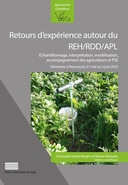Explore

Sampling, interpretation, modelling, farmer support and PES.
0 Ungluers have
Faved this Work
Login to Fave
In agriculture, nitrogen is a major component of plant production. However, its nitric form (very soluble in water) presents a major risk in the soil for aquifers, the environment (eutrophication) and drinking water production. Measurements of mineral nitrogen residue in the soil of cultivated plots have been carried out in autumn for sometimes more than twenty years in various regions of France and Belgium. This residue is called (sometimes with some nuances) Potentially Leachable Nitrogen (PLN), Winter Entry Residue (WIN) or Drainage Start Residue (DSR). These three terms illustrate both the measurement period (early winter) and the process involved (leaching).
These measurements are carried out for different, often complementary, purposes:
- understanding the determinants of water quality and developing models
- understanding the links between RDD and agricultural practices,
- encourage changes in agriculture,
- raising farmers' awareness of water quality and its determinants,
- supporting farmers to obtain quality water,
- monitoring the evolution of water quality,
- evaluate farmers' practices in regulatory actions,
- remunerate farmers based on water quality objectives to be achieved.
From 31 May to 3 June 2022, twenty-one users (French and Belgian) of this soil nitrogen residue measurement shared their experiences during a seminar organised in Peyresq. These exchanges enabled each of them to deepen their understanding of their work with a view to disseminating it to new users through this book.
This book is included in DOAB.
Why read this book? Have your say.
You must be logged in to comment.
Rights Information
Are you the author or publisher of this work? If so, you can claim it as yours by registering as an Unglue.it rights holder.Downloads
This work has been downloaded 79 times via unglue.it ebook links.
- 38 - epub (CC BY) at Unglue.it.
- 41 - pdf (CC BY) at Unglue.it.
Keywords
- RND
- TB
Editions

